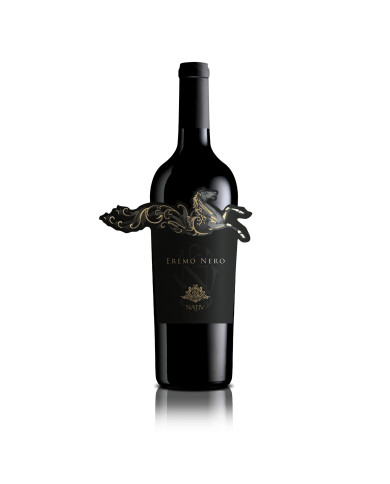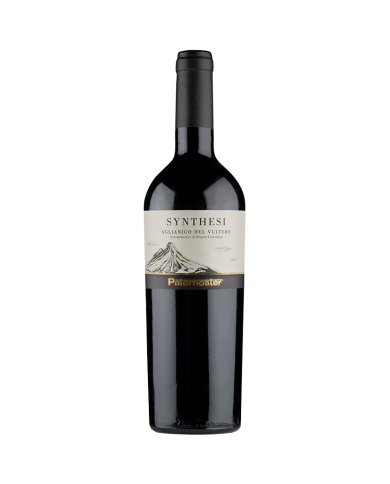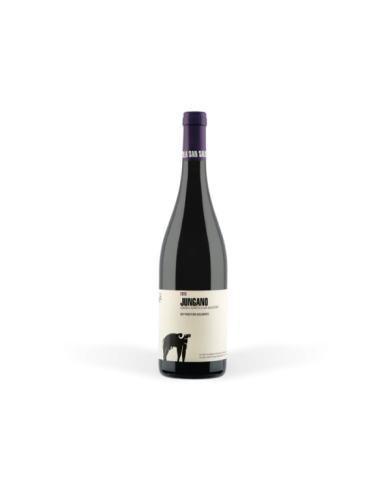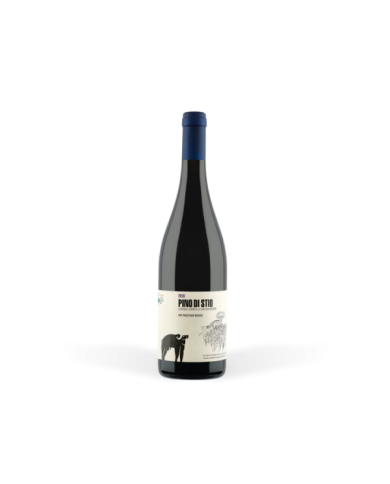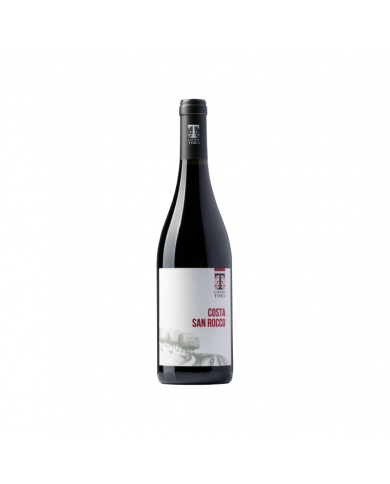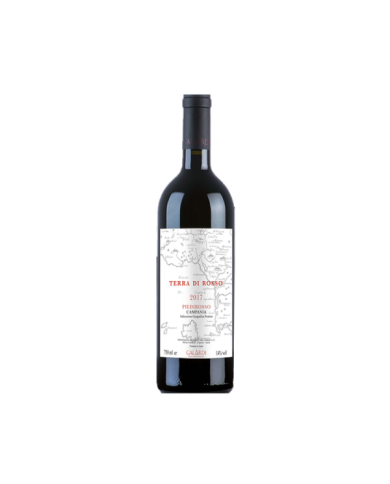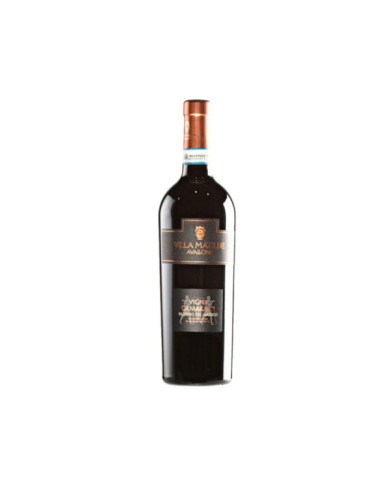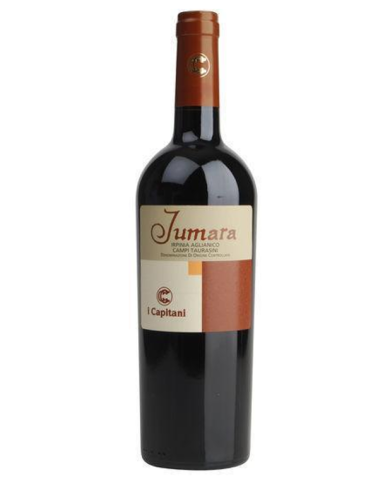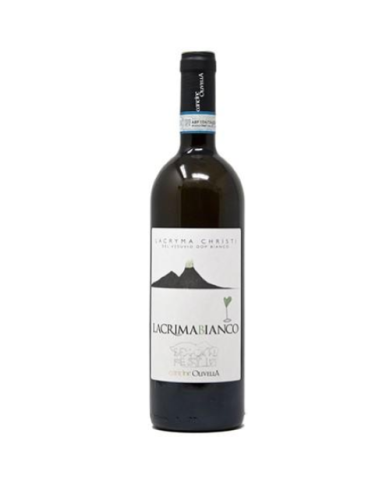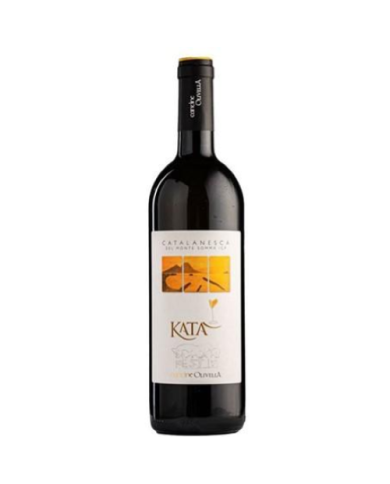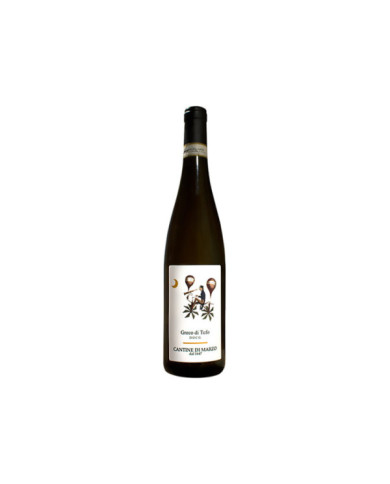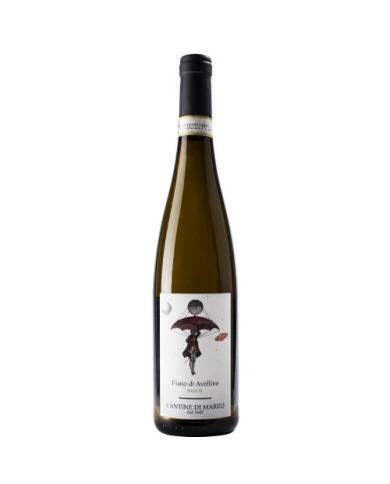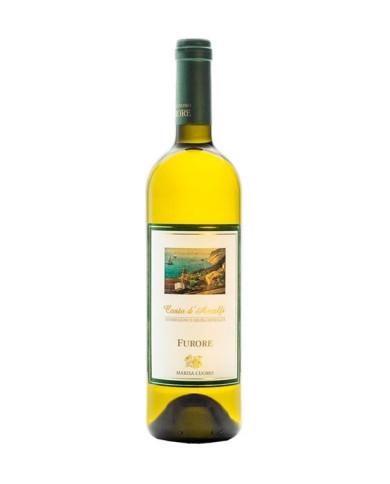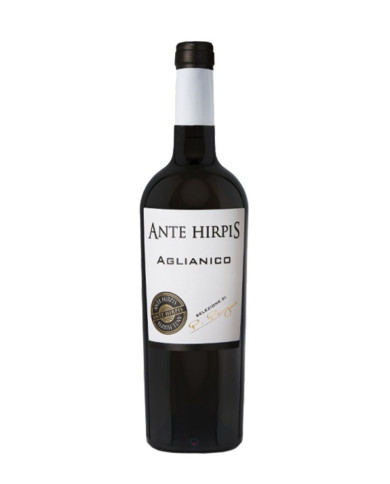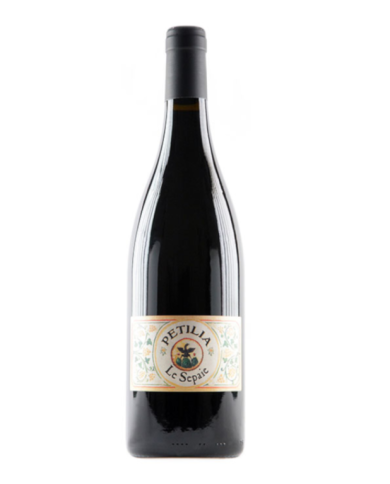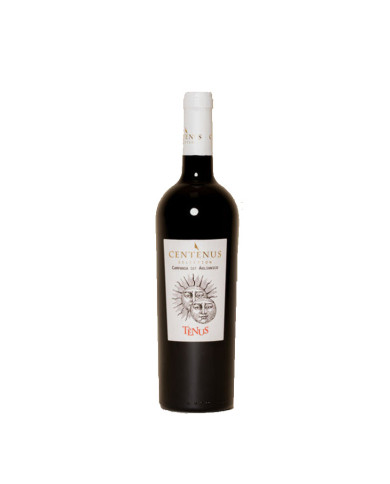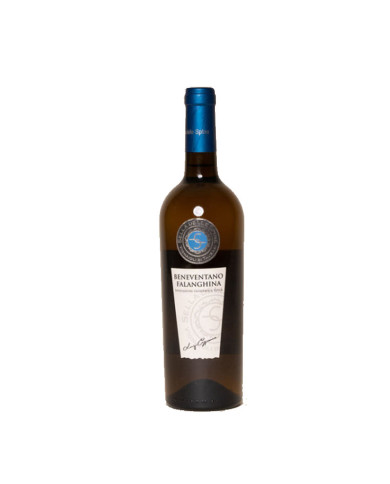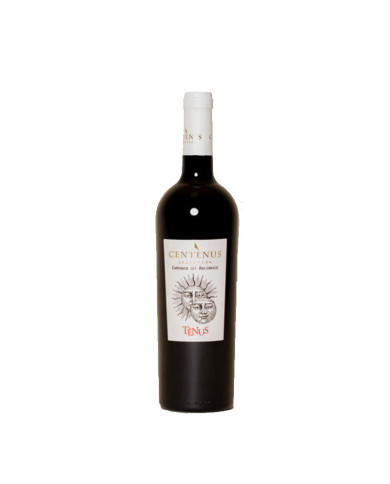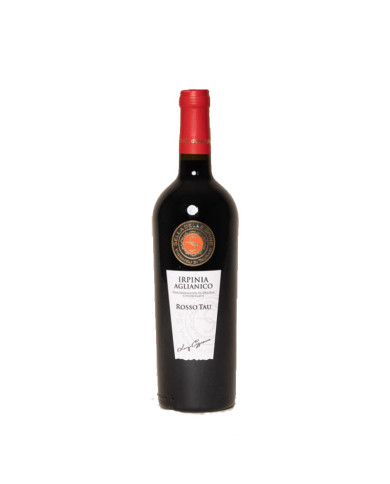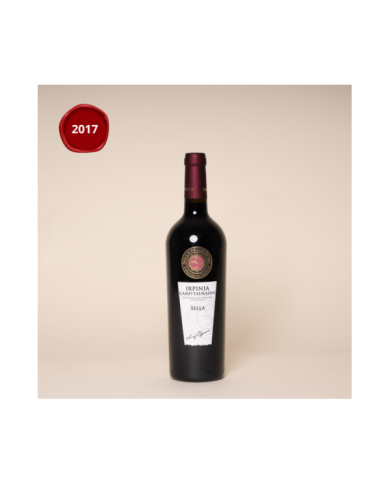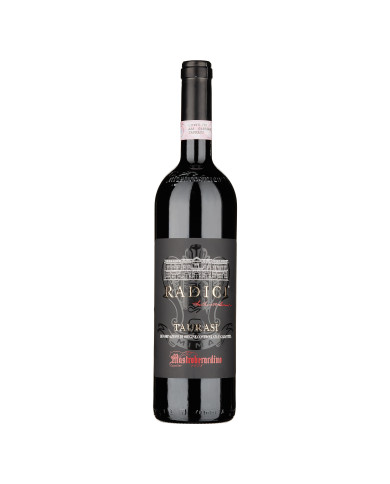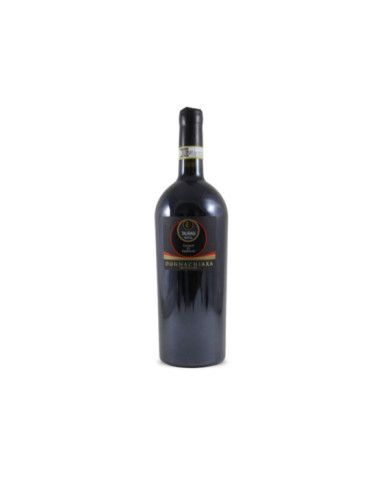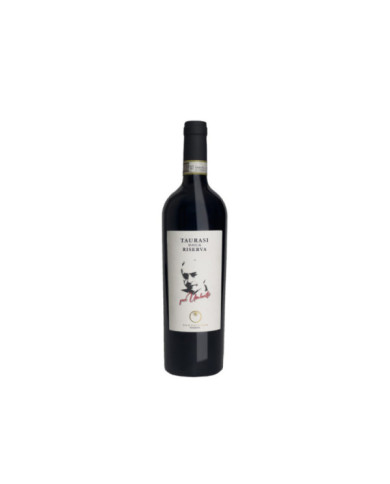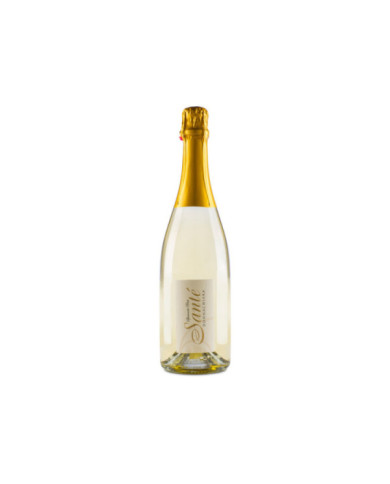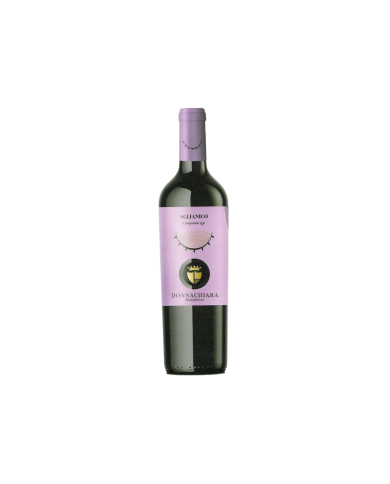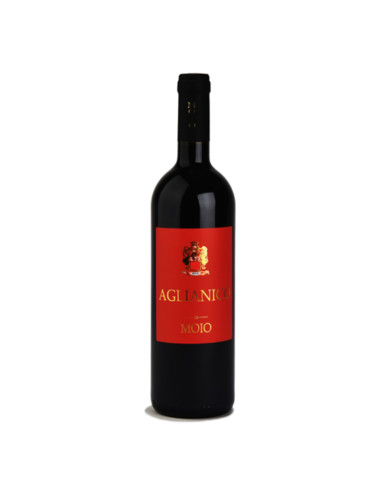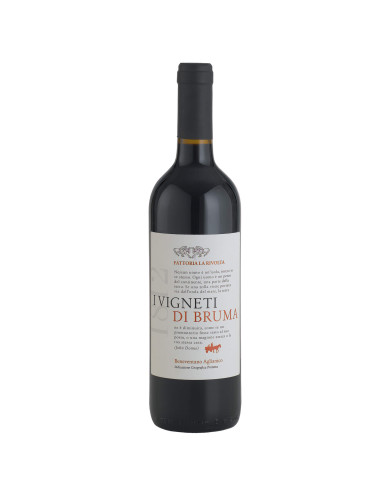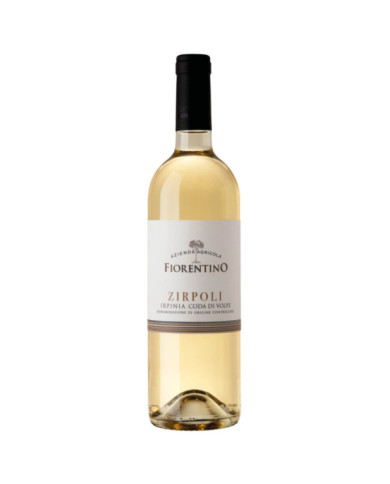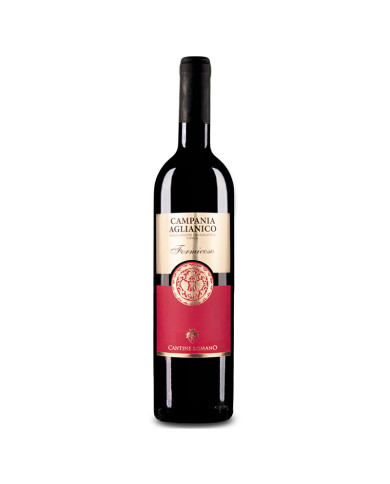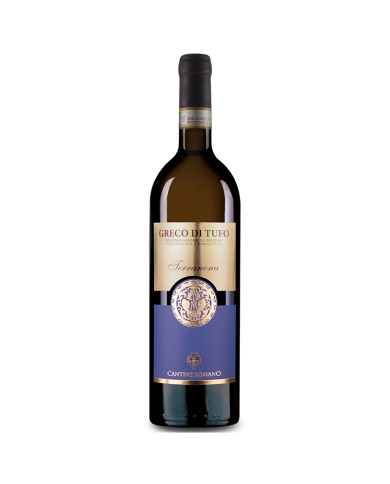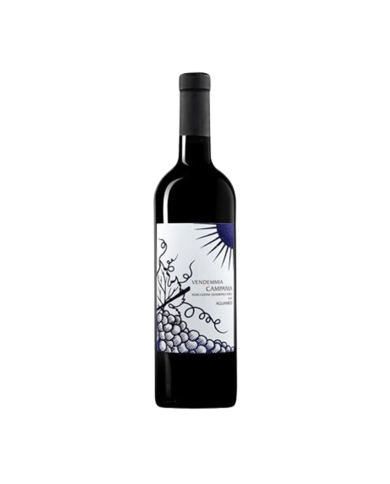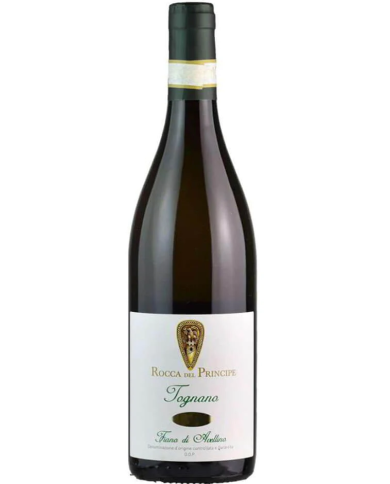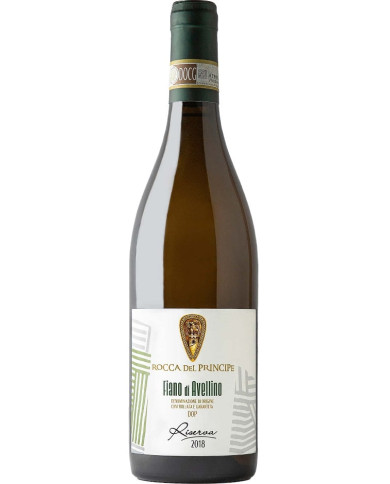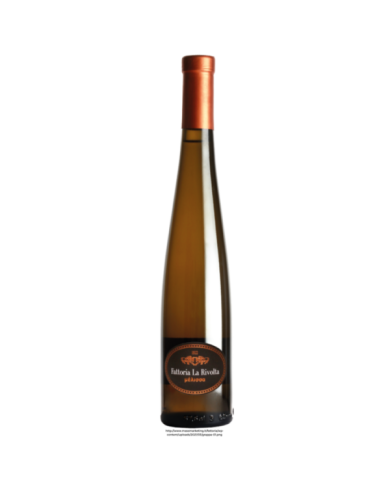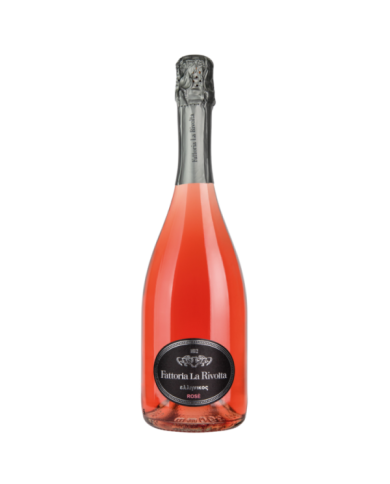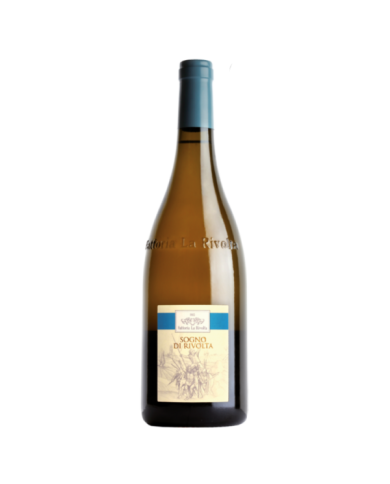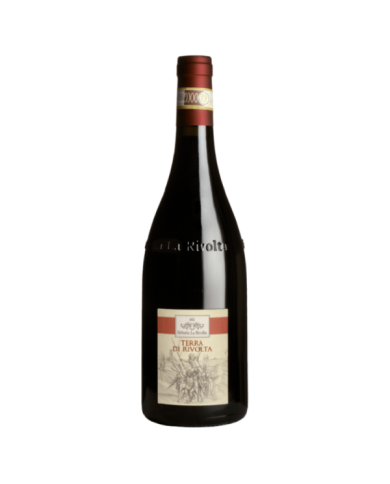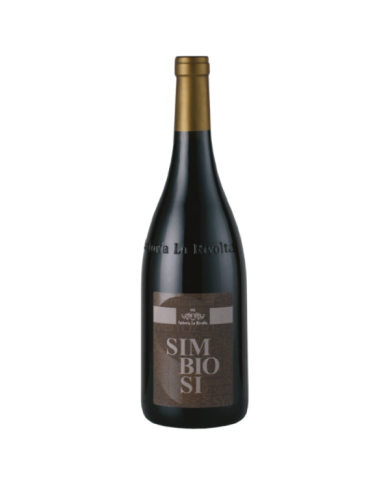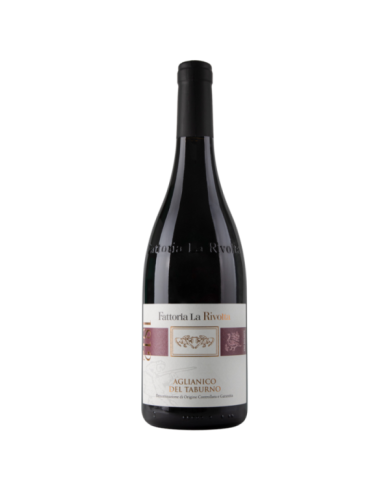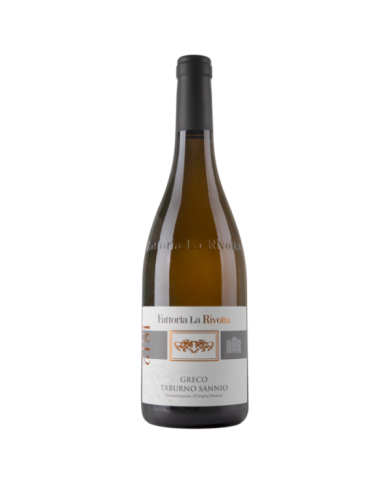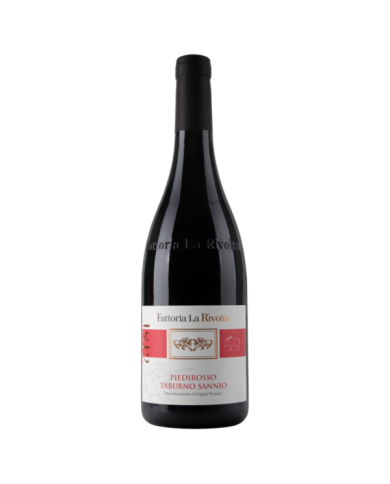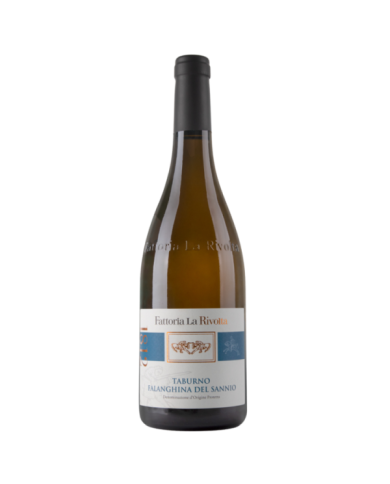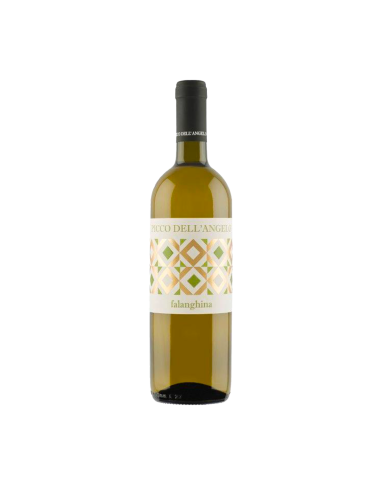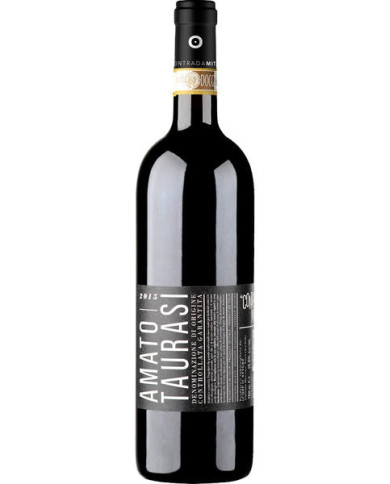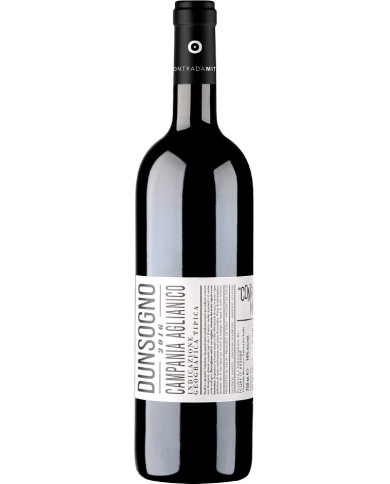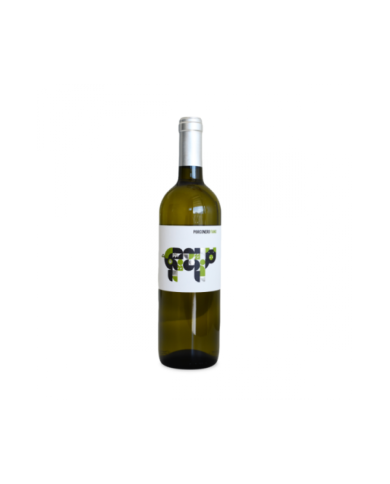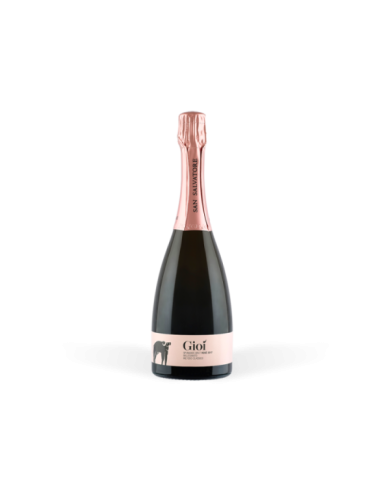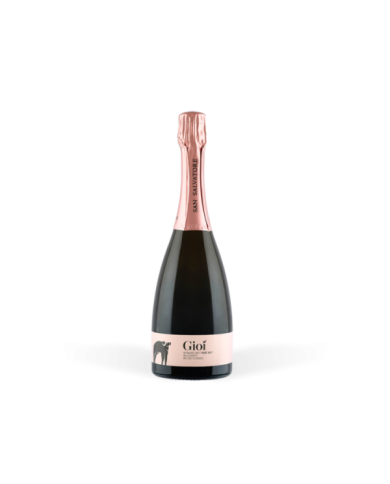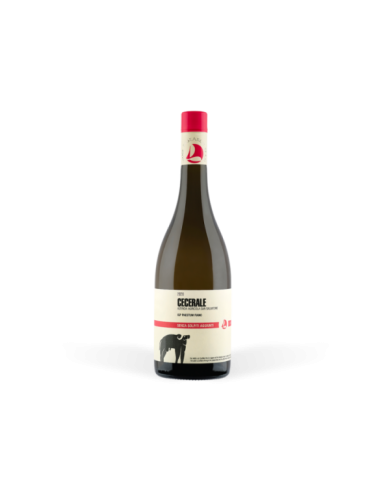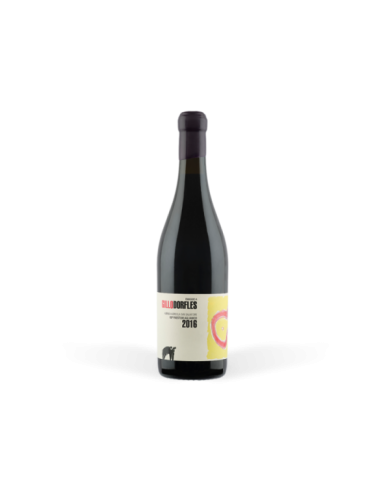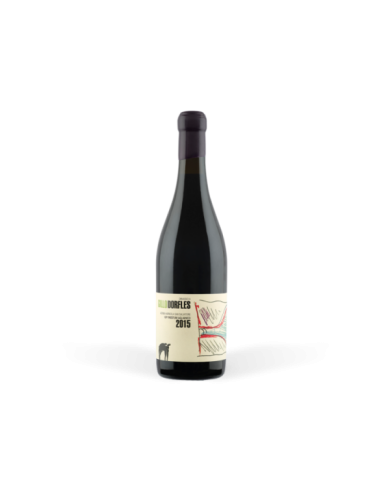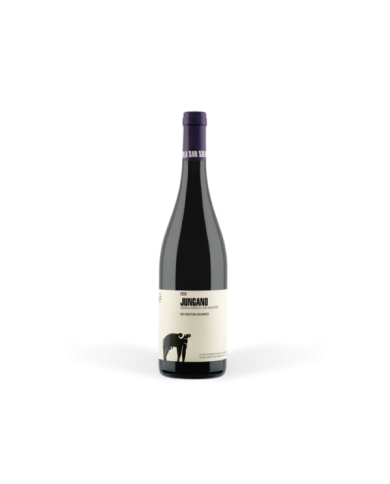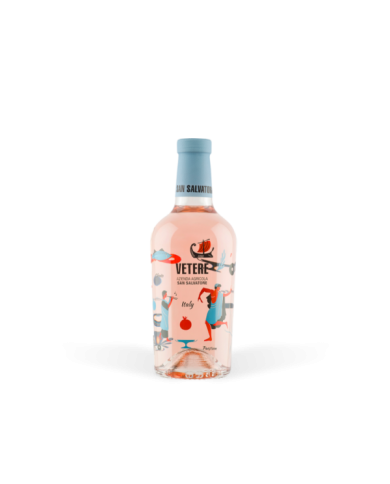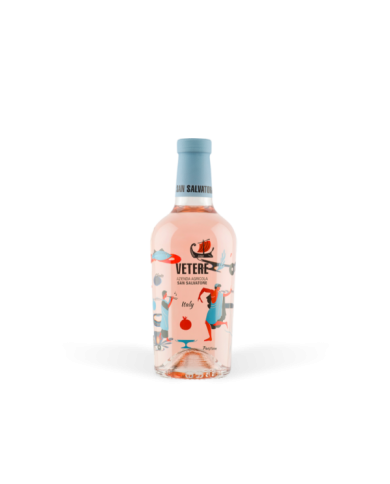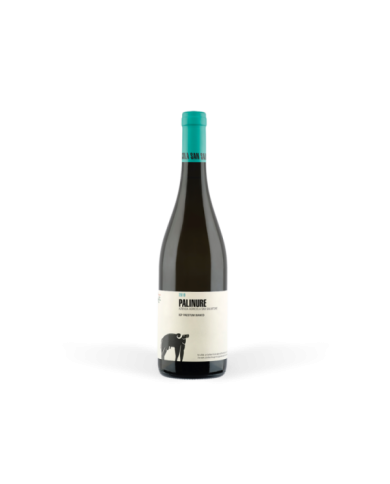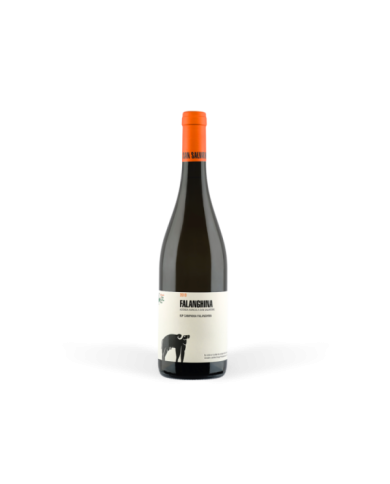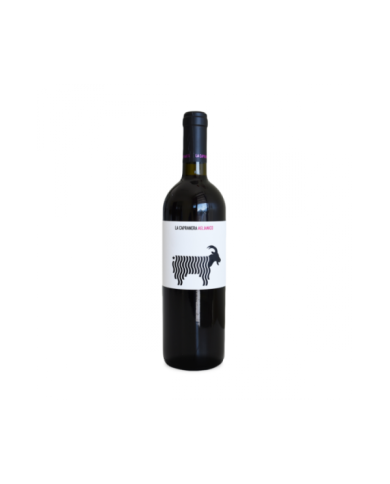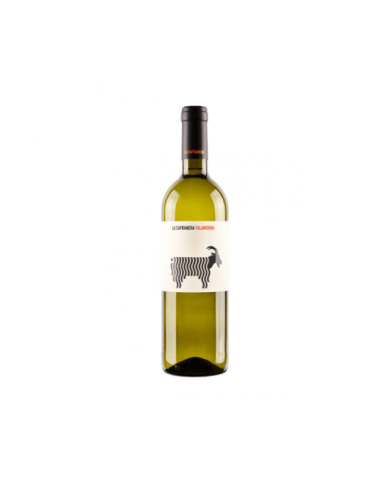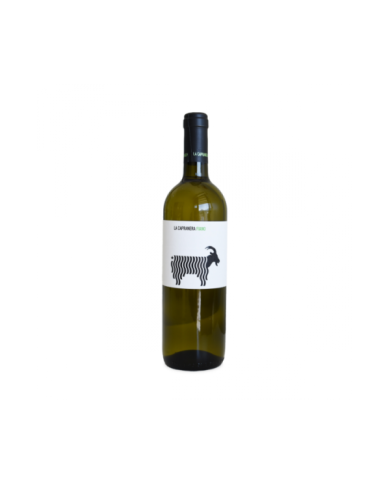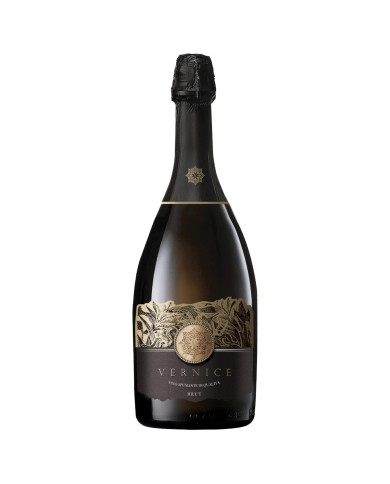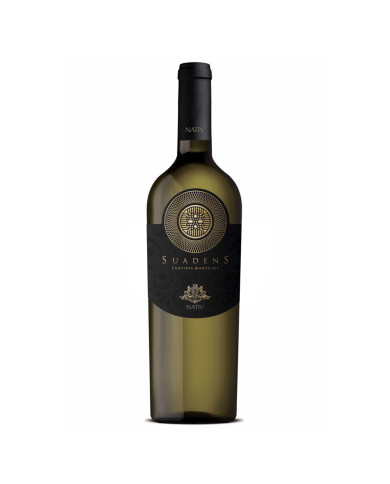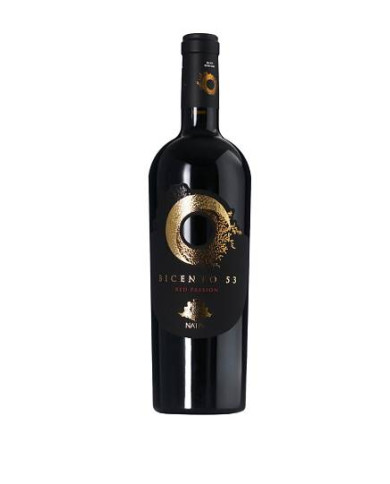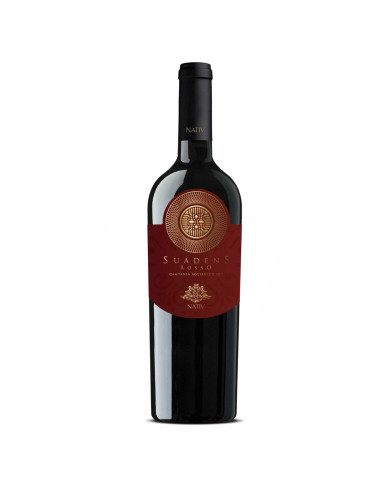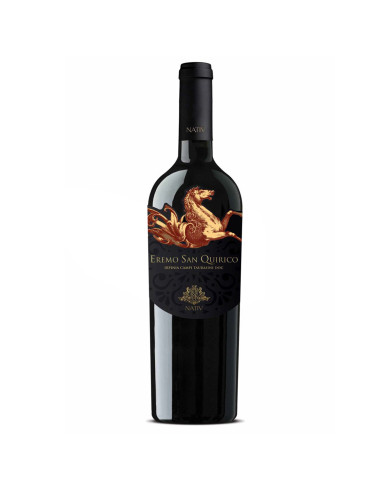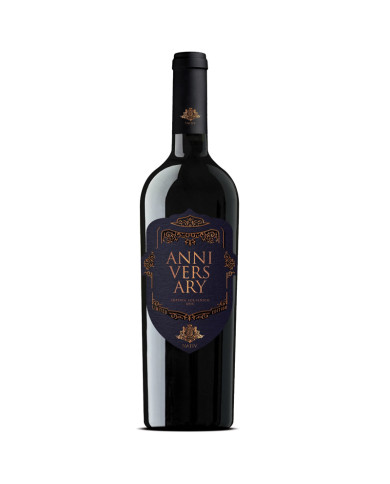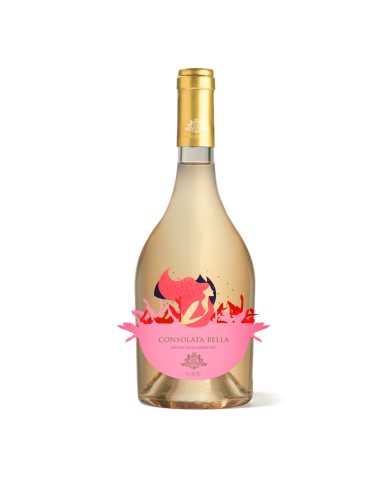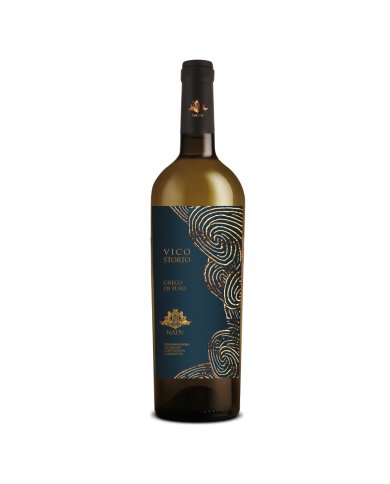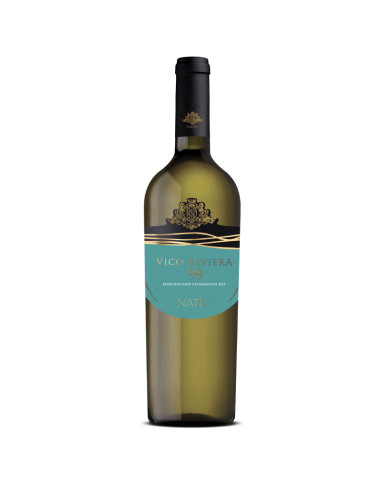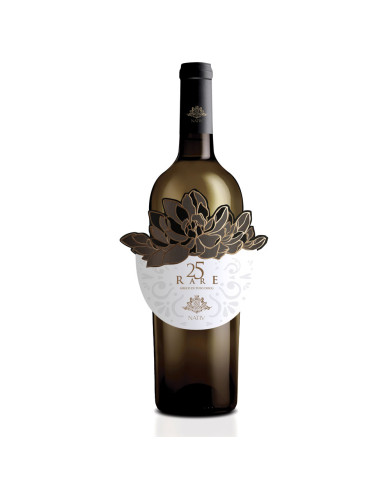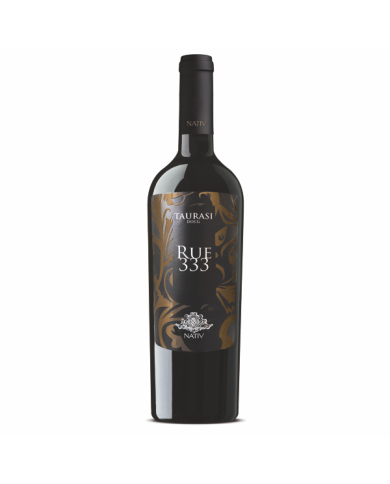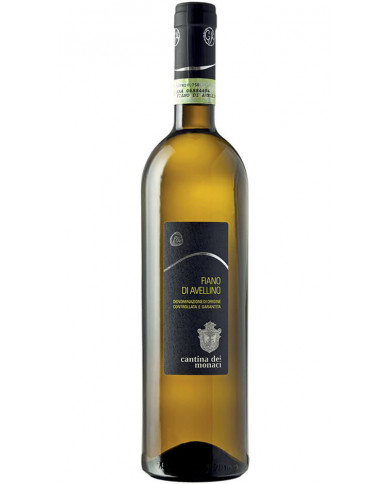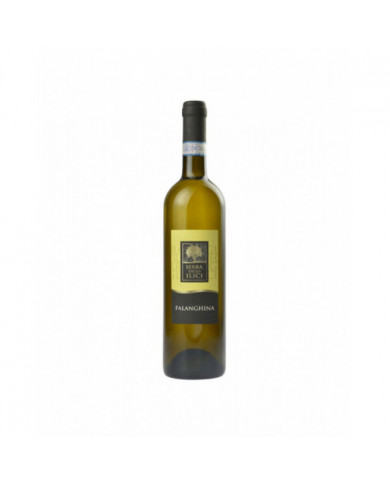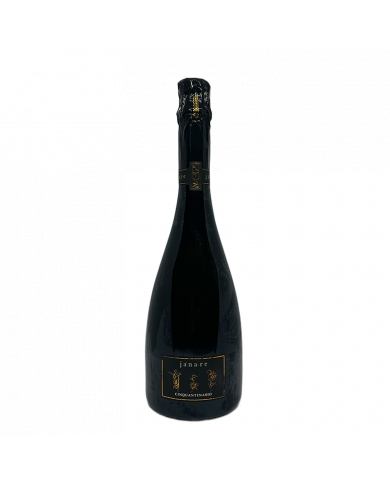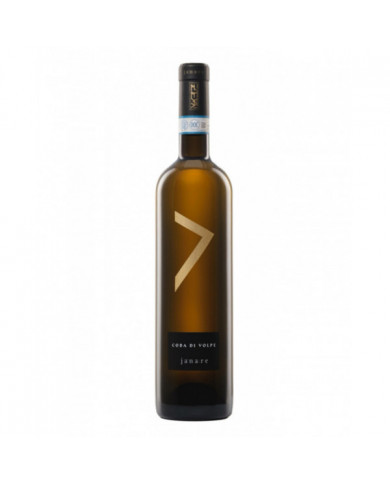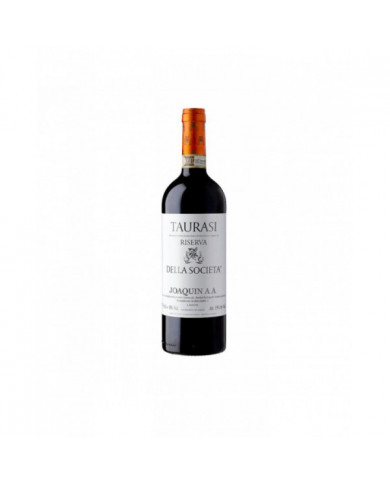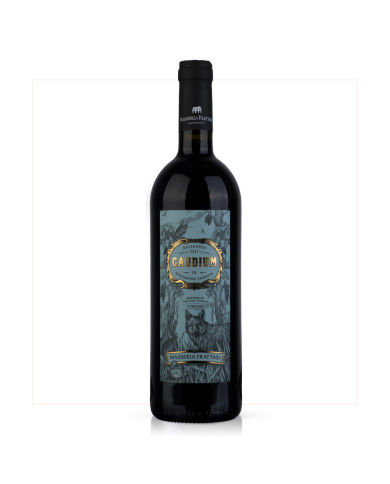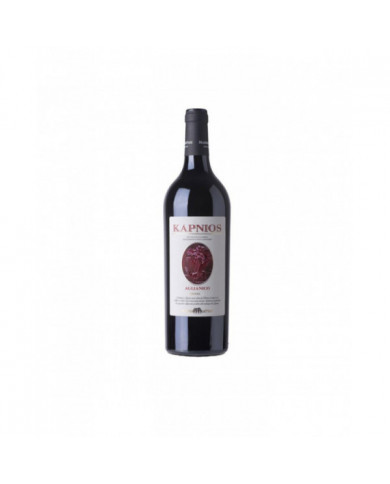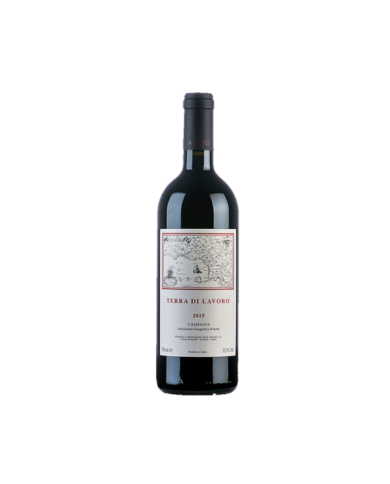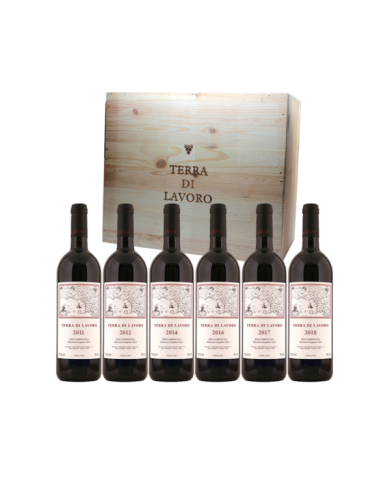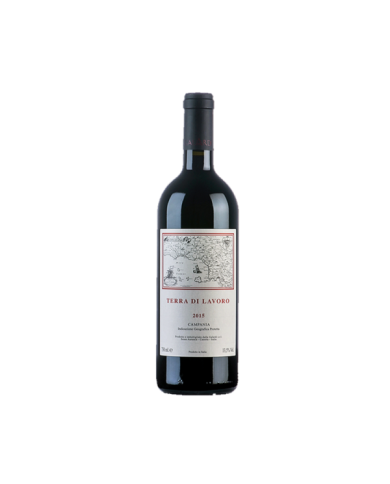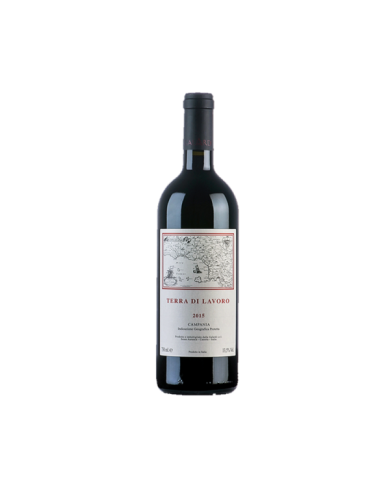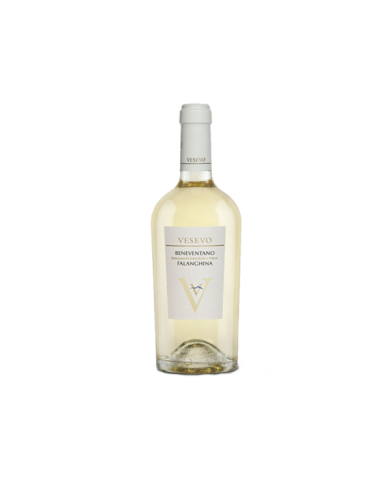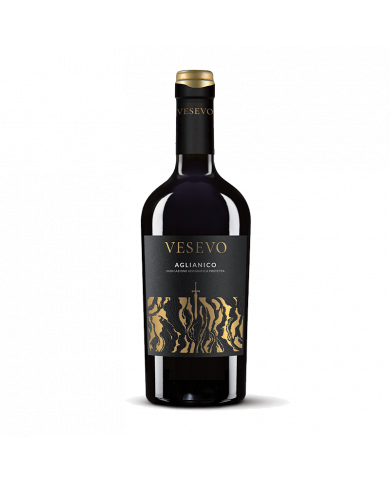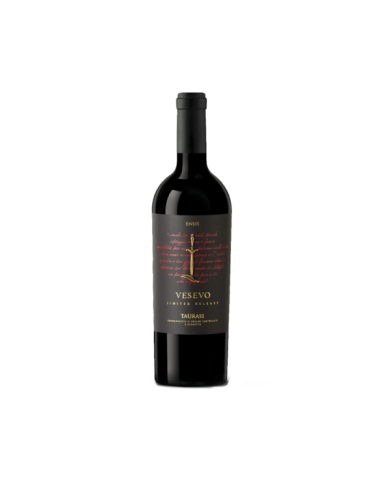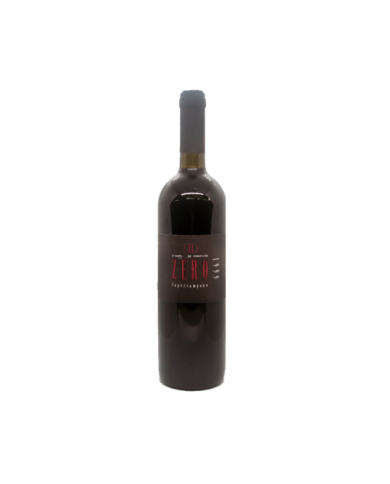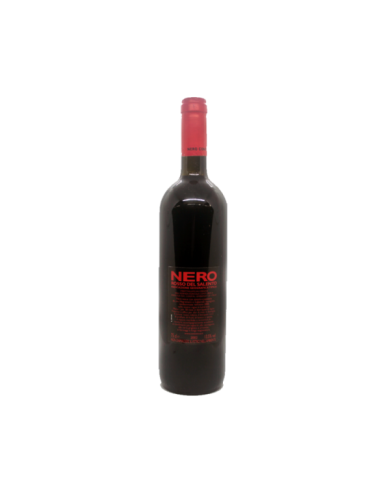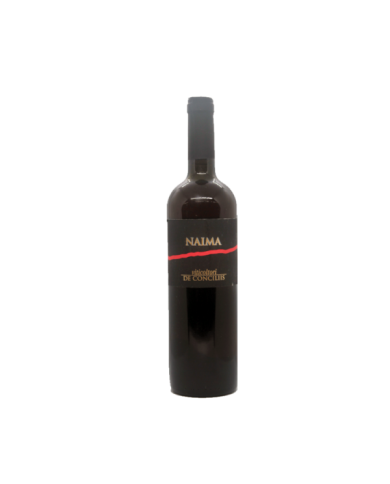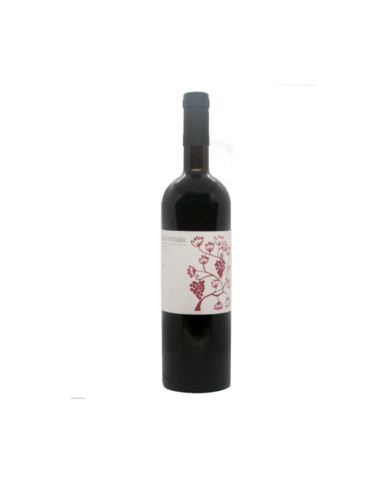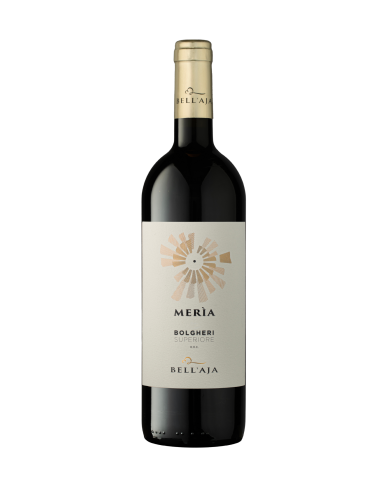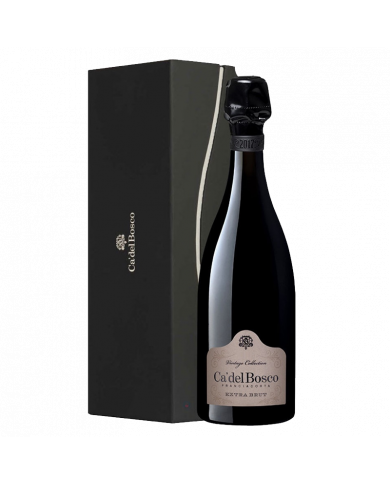Eremo Nero, born from the vinification of Aglianico grapes grown on volcanic soils in the Paternopoli countryside. The composition of these sandy soils, with very fine and particularly permeable ash, is the ideal condition for obtaining high quality grapes and still red wines rich in anthocyanins and tannins.
100% Aglianico. Maturation of the wine for 40% in second passage French oak barriques, 40% in 25 hl barrels and the remainder in steel tanks.
Vino di grande complessit├Ā olfattiva, con una serie di note floreali che si svelano una dopo l'altra. Al sorso non delude e porta con s├© una magnifica sapidit├Ā. Note Degustative: Summa di Cantine Olivella ├© un vino dal colore giallo oro. All'olfatto ├© delicato, con note di fiori e frutta, complesso, e sapido. Abbinamenti alimentari: Sformati di pasta, torte di verdure, formaggi a pasta filata.
Fermentazione e Affinamento: affina sulle fecce fini per 4 mesi e 2 mesi di bottiglia Uvaggio: Caprettone 80%, Catalanesca 20%
Nel calice ├© consistente con colore giallo dorato, naso fruttato con note di albicocca, sentori delicati di fiori e mineralit├Ā. LŌĆÖassaggio d├Ā sensazioni di freschezza e morbidezza con un piacevole finale ammandorlato
Nel calice ├© consistente con colore giallo dorato, naso fruttato con note di albicocca, sentori delicati di fiori e mineralit├Ā. LŌĆÖassaggio d├Ā sensazioni di freschezza e morbidezza con un piacevole finale ammandorlato.
Colore giallo paglierino scarico e delicato profumo di frutta che riporta agli inconfondibili odori mediterranei della zona di origine. Il sapore ├© ampio ed equilibrato con una lieve dominanza della nota acidula a sostegno della freschezza degli aromi.
L'Irpinia Campi Taurasini DOC ŌĆ£SellaŌĆØ ├© un vino dal colore rosso rubino e dal profumo di marasca, prugna e frutti di bosco, ai quali si aggiungono alcune note speziate.
L'Irpinia Campi Taurasini DOC ŌĆ£SellaŌĆØ ├© un vino dal colore rosso rubino e dal profumo di marasca, prugna e frutti di bosco, ai quali si aggiungono alcune note speziate.
Il Taurasi DOCG ŌĆ£Vigna Piano DŌĆÖAngeloŌĆØ ├© un vino dal colore rosso rubino intenso e dal profumo ampio e fruttato, che richiama i sentori di prugne e ciliegie e le fragranze del sottobosco collinare che caratterizzano i territori taurasini.
Mastroberardino 's Taurasi "Radici" is a full-bodied red wine, very representative of the appellation. Aging in wood for 18 months makes it ample, elegant and complex: notes of wild berries combine with aromas of tobacco, spices and black pepper for a balanced and enveloping result
Il Taurasi Riserva dell'Azienda agricola Fiorentino nasce nel vigneto Calore, a un'altitudine media di 400 m. s.l.m. Le uve, vendemmiate a mano tra fine ottobre e inizio novembre, seguono una classica vinificazione in rosso con macerazione sulle bucce a temperatura controllata. Il vino ottenuto affina per 18 mesi in botte grande da 10 hl e successivamente in acciaio e bottiglia.
Il Taurasi dell'Azienda agricola Fiorentino nasce nel vigneto Calore, a un'altitudine media di 400 m. s.l.m. Le uve, vendemmiate a mano tra fine ottobre e inizio novembre, seguono una classica vinificazione in rosso con macerazione sulle bucce a temperatura controllata. Il vino ottenuto affina per 12 mesi in botte grande da 25 hl e successivamente in acciaio e bottiglia.
L'Irpinia Coda di Volpe Zirpoli dell'Azienda agricola Fiorentino nasce nel vigneto Barbassano, a un'altitudine media di 450 m. s.l.m.
LŌĆÖaglianico Cels├¼ non ├© da considerarsi come unŌĆÖetichetta ŌĆ£minoreŌĆØ rispetto al Taurasi, quanto piuttosto come un vino di pari livello, nonostante la differenza di prezzo. Trattasi di un grande vino, complesso e strutturato, dal lungo potenziale dŌĆÖinvecchiamento. Nuances fruttate si alternano a toni affumicati, al palato ├© ampio e agile, dalle note saline e tannini vellutati. Circa 4mila bottiglie prodotte, tutte numerate a mano. Imperdibile!
Impenetrable ruby red with hints of red fruits, sour cherries and hints of undergrowth; in the mouth direct, vigorous and never invasive; pronounced and persistent tannins, good structure; complex sense of smell.
A fruity aftertaste, a fine persistence, a fresh and savory timbre, a good body with floral notes, an intense and soft tone.
Crushing-destemming, fermentation in steel at uncontrolled temperature for 15 days. Stop for 12 months on the fine lees and at least 4 months in the bottle. A wine that the vintage has made easy to drink without betraying the olfactory and spicy qualities typical of this wine.
Aglianico Torre Varano is the red wine that you will appreciate for its gustatory balance, acquired with the aging time.
Aglianico is the vine which, together with Fiano, represents the peasant culture of the Campania region. The soil where this vine is found is composed of clayey and calcareous marl with a South/East exposure. The company begins harvesting the grapes from the beginning of November and, after pressing, the must ferments in contact with the skins for about 25 days. This is followed by malolactic fermentation and subsequent aging in barriques for 12 months and 12 in Slavonian oak barrels. The refinement in the bottle is for another 18 months. In the glass this wine has an intense ruby red colour. The nose is intoxicated by its large bouquet of black cherry, plum, spices, tobacco and balsamic notes. On the palate it is decisive, warm, rich and rightly tannic. The finish is long and persistent with an aroma reminiscent of ripe fruit. On the table it is excellent in combination with first courses with meat sauce, roasted red meats and aged cheeses. A quality red to be enjoyed and savored in good company.
Cru Tognano is obtained by selecting the grapes produced by plants grafted with the centenary Fiano clone. Exposure East Clayey sandy soil of medium texture, dry and windy climate, altitude 550 above sea level, presence of numerous water springs, a set of factors that characterize this cru. The company begins harvesting the grapes in the first ten days of October and, after pressing, subjected to maceration on the skins for about 15 hours, the free-run juice obtained ferments in steel for about 45 days. The alcoholic fermentation is followed by an aging in steel for 12 months and a further aging in the bottle for a minimum of 12 months. In the glass this wine is straw yellow in color with delicate greenish reflections. On the nose, the aromas of citrus fruits and white-fleshed fruit, mint, toasted notes and hydrocarbons stand out which evolve over time, becoming increasingly striking and intense. In the mouth the taste is fresh and with a long aromatic persistence with returns of citrus and smoky notes. This white is excellent in combination with fish dishes, white meats and fresh cheeses.
Rocca del Principe presents its pure Fiano, the first born in the "Riserva" version. The wine must have aged for at least 12 months, starting from the month of November following the harvest. An excellent wine capable of making its origin known even with closed eyes: the territory of Lapio where the cellar is located. An area particularly suited to viticulture, especially for Fiano grapes, especially in the north, north-east side. The particular characteristic of the wines produced in this area is an unexpected longevity. In the glass it shows a beautiful clear and light yellow color. The nose is extremely intense, the hints of yellow fruit such as peach are evident as well as aromas of more exotic fruit, combined with brackish nuances and hints of flint. Perfect harmony between nose and mouth. The taste is decidedly fresh and salty, with an energetic acidity. A highly versatile wine that goes perfectly with many dishes based on fish or white meat. Excellent with margherita pizza.
Every year this wine, produced exclusively with Fiano grapes obtained from the company's vineyards, is the expression of a territory. The only factor that can significantly vary the characteristics is represented by the climatic trend of the different years. The company begins harvesting the grapes in the first ten days of October and, after pressing, follows the alcoholic fermentation in steel tanks at a controlled temperature of 12/14┬░ for about 40 days. Malolactic fermentation is partially carried out, followed by aging in steel on fine lees for 10 months. The refinement in the bottle is for another 4 months. In the glass this wine is straw yellow in color with delicate greenish reflections. The nose is fine and delicate but at the same time persistent and intense with fruity, floral, mineral and vegetable notes. The aromas of orange blossom, cedar, fresh almonds and aromatic herbs stand out in particular, which over time evolve into aromas of toasted hazelnuts, dried fruit and hints of hydrocarbons. In the mouth the taste is dry, fresh, sapid and with a long aromatic persistence. At the table it marries beautifully in combination with fish dishes, white meats and fresh cheeses.
Aglianico is the vine which, together with Fiano, represents the peasant culture of the Campania region. This vine has always been cultivated by the ancestors to make a wine which, left to mature in chestnut barrels for 12 months, was then sold in bulk to local merchants. Today, the company begins harvesting the grapes from the beginning of November and, after pressing, the must ferments in contact with the skins for about 15 days, followed by malolactic fermentation and subsequent aging in French oak barrels for 12 months and 6 months in the bottle. In the glass this wine has an intense ruby red colour. The nose releases a riot of aromas and perfumes; a large and complex bouquet with hints of black cherry, plum, spices and balsamic notes. On the palate it is decisive, warm, rich, with well-defined but soft tannins. The finish is long and persistent, excellent to be enjoyed in the company of pasta dishes, cheese platters and meat-based dishes. An exceptional red that exudes passion and tradition, this Aglianico is the right wine to bring when you are invited to a meat lunch or dinner with friends or relatives.
Aglianico is a grape brought by the Greeks from which the name of "Uva Ellenica" transformed during the Kingdom of Naples into "Uva Aglianica" by the Aragonese due to their pronunciation of the double "l" in "gl".
"Amato Taurasi" is a refined red wine produced with carefully selected Aglianico grapes. In Nusco, a small town between the Ofanto and Calore valleys, three friends together produce a red wine capable of representing a typically Irpina reality, but which at the same time demonstrates and encompasses an international style, the Taurasi Amato. The color with which it appears to the eye is a dark, intense and brilliant ruby red. A wine capable of giving the nose pleasant floral and fruity odorous sensations, reminiscent of black fruits and rose flowers, amalgamated with hints of wild violets and a surprising aroma of licorice. In the mouth the sip is refined, rich and soft, with silky tannins and the long finish to be savored without haste which guarantees a broad sense of satisfaction on the palate. Excellent to serve together with pasta with meat sauce, game stews, aged cheeses or with delicious grilled livers.
Costa d'Amalfi Bianco is characterized by a straw yellow color with an elegant aroma of acacia, lemon verbena and aromatic herbs and a finish reminiscent of toasted almonds. The taste is appreciated for its balance and lively freshness.
Porconero Falanghina Campania IGP white wine. Only falanghina aged in steel tanks for six months.
Porconero Fiano Campania igp. Pure Fiano aged in steel tanks for about eight months.
100% Aglianico worked in steel, aged in new French oak barriques for two years and then aged in glass. Dedicated to the late and great Trieste scientist Gillo Dorfles, friend of Peppino Pagano.
100% Aglianico worked in steel, aged in new French oak barriques for two years and then aged in glass. Dedicated to the late and great Trieste scientist Gillo Dorfles, friend of Peppino Pagano.
100% Aglianico. Maturation of the wine for 40% in second passage French oak barriques, 40% in 25 hl barrels and the remainder in steel tanks.
100% Aglianico. Maturation of the wine for 40% in second passage French oak barriques, 40% in 25 hl barrels and the remainder in steel tanks.
The Capranera Aglianico Campania IGP red wine. 100% Aglianico processed for eight months in steel tanks.
Important red wine whose vines are grown on volcanic soil on the hills of Taurasi. The name of our wine derives from the place where horses were once said to graze in the wild, and where the remains of the ancient hermitage of S. Quirico can still be found. A wine so precious as to dress it with a work of art by the contemporary painter Moreno Bondi.
Spumante Brut Varnish is crystalline in colour, yellow with greenish reflections, with a light, fine, rapid perlage. It has a pleasant, fruity, floral, intense, flagrant aroma. On the palate, a development of CO2, lively acidity, good acidity/sugar balance.
Rue De' Passi is a Campania Rosso Amabile IGT, the fruit of an Aglianico vineyard located in close proximity to the cellar, in the heart of Paternopoli. The harvest of this vineyard is carried out late, giving the grapes a greater residual sugar. The name "Rue de Passi" is in memory of the path that leads from the cellar to the vineyard in a few steps.
Wine produced from the vinification of Aglianico grapes from bicentenary vineyards that survived the phylloxera parasite that almost entirely destroyed the vineyards in Europe in the 1950s. The longevity of these vineyards inspired the name of this wine, available in limited quantities.

The name "Suadens" was carefully selected to represent the persuasive character of this wine, which constitutes a molecular project aimed at enhancing not only the native vines of Irpinia, but also the typical local fruit, grown exclusively in this area.
Precious red wine whose vineyards grow on volcanic soils, on the Corne di Turasi. The name of this wine is due to the longevity of the vineyards from which it is made, which are 200 years old. Bicento literally means "twice a hundred".
Suadens Rosso ŌĆō Campania Rosso IG T. The name "Suadens" was carefully selected to represent the persuasive character of this wine, which constitutes a molecular project aimed at enhancing the native vines of Irpinia, but also the typical local fruit, grown exclusively in this area. Suadens Rosso is a selection of the best Aglianico grapes from the Irpinia area.
Important red wine whose vines are grown on volcanic soil on the hills of Taurasi. The name of our wine derives from the place where horses were once said to graze in the wild, and where the remains of the ancient hermitage of S. Quirico can still be found. Eremo Gold is the selection of the best Eremo Barriques. On the occasion of the last bottling, before the Christmas period, each barrique of Eremo is personally tasted by the enologist Ercolino who personally selects the best aromas and refinements.
Eremo San Quirico ŌĆÉ Aglianico Campi Taurasini DOC Important red wine whose vines are grown on volcanic soil on the hills of Taurasi. The name of our wine derives from the place where horses were once said to graze in the wild, and where the remains of the ancient hermitage of S. Quirico can still be found. A wine so precious as to dress it with a work of art by the contemporary painter Moreno Bondi.
Choose Anniversary for your special occasions: a wine designed for memorable dates, a real pleasure for the palate in a unique and unmistakable packaging
Eremo Nero, born from the vinification of Aglianico grapes grown on volcanic soils in the Paternopoli countryside. The composition of these sandy soils, with very fine and particularly permeable ash, is the ideal condition for obtaining high quality grapes and still red wines rich in anthocyanins and tannins.
Valentina was arrogant, know-it-all, presumptuous, like her beauty, pure, alive, unique. If you wanted to define her in one word, there was no more suitable adjective: vain. At every step there was no mirror in which she didn't like to reflect herself, shop windows were her favorite mirrors because the whole city was full of them; the mirrors of the boutiques and beauty salons represented a daily practice in which to look in the mirror; even the pure porcelain saucers of the bistros were an excellent mirror for her, when, raising her cup to sip tea, she admired her reflection.
In 1950, in the town of Paterdoro there was a young girl, known for her long red hair who everyone called disconsolate, as her handsome boyfriend, a colonel in the Italian army had gone to war and never returned. The people of the village tried to bring comfort to the young woman, who gave her bouquets of fresh flowers just picked in the field, who gave her baskets of wild strawberries just to make her smile.
Ancient vine introduced by the Greeks along the Tyrrhenian coasts, whose name derives from the characteristic shape of the bunches, whose grapes are grouped in pairs, from which the name Aminea Gemina derives. The mineral-rich soil, typical of the Greco cultivation area, is particularly suitable for this grape variety and this gives the wine its characteristic sapidity.
Vico Riviera N┬░ 99 Falanghina Beneventano IGT Ancient vine whose name seems to derive from the fact that the vine, with an expanded habit, was tied to support poles called "falanga" and therefore Falanghina or "vine supported by poles".
Rue dell'Inchiostro Campania Aglianico IGT Grape introduced by the Greeks along the Tyrrhenian coast, at the time of the foundation of their colonies (VII-VI aC ); this could explain the presence of synonyms of Ellenico, Ellanico then changed into Aglianico. The name deriving from the combination between Rue, the typical name attributed to the streets of Paternopoli following the passage of French domination and "ink" which better defines the characteristic deep purple of the wine.




SecretsŌĆ” from 100% Aglianico Nero grapes, from volcanic lands in the districts of Valle del Ceraso and Fontana Marena, in the countryside of Paternopoli from an unusual November harvest. Macerates and ferments with its own yeasts, then in seasoned oak wood for a year and a half, waiting for six months in the bottle... it is a generous wine in its most authentic organoleptic values.
Ancient vine introduced by the Greeks along the Tyrrhenian coasts, whose name derives from the characteristic shape of the bunches, whose grapes are grouped in pairs, from which the name Aminea Gemina derives. The mineral-rich soil, typical of the Greco cultivation area, is particularly suitable for this grape variety and this gives the wine its characteristic sapidity.
Ancient vine, of which we find the first traces in Pliny the Elder; the Apian grapes, from which the name of today's Fiano derives, were characterized by an intense sweetness and therefore particularly loved by bees.
Vico Riviera N┬░ 99 Falanghina Beneventano IGT Ancient vine whose name seems to derive from the fact that the vine, with an expanded habit, was tied to support poles called "falanga" and therefore Falanghina or "vine supported by poles".



So called because there are so many "grade: rare" steps that connect the historic center of Paternopoli to the part completely rebuilt after the 1980 earthquake
The name "Velluto Rosso" was chosen thinking of the organoleptic characteristics of the wine: soft on the palate and such as to suggest velvet, a fabric that causes a sensation of irresistible softness to the touch. The red color of the label reminds us of a bunch of grapes and the damask is in perfect harmony with the Nativ style.
Rue 333, Taurasi DOCG Wine made from Aglianico grapes, whose refinement in barriques for two years, gives it the specific name of Aglianico Taurasi DOCG also in honor of the country where this type of grape is widely grown.








Eremo San Quirico ŌĆÉ Aglianico Campi Taurasini DOC Important red wine whose vines are grown on volcanic soil on the hills of Taurasi. The name of our wine derives from the place where horses were once said to graze in the wild, and where the remains of the ancient hermitage of S. Quirico can still be found. A wine so precious as to dress it with a work of art by the contemporary painter Moreno Bondi.





the wine takes its name from the vineyard of the same name located on rocky terrain near an ancient onyx quarry located near gesualdo.
Among the vineyards of Irpinia, from the Latin Hirpus-wolf, a young Aras girl roamed around some time ago, a lover of the wonderful bunches of grapes.
Montecaruso DOC Galluccio Rosso has an intense ruby red color with violet reflections, offers the nose aromas of red fruit and spices, with hints of leather and undergrowth, blueberries, currants, sour cherries jam, peony, red roses and licorice roots on a vegetal background .
Brilliant straw yellow colour, characteristic fruity bouquet of good intensity with hints of cedar, citrus, white fruit and yeasts. Pleasant, with a good structure and excellent persistence. Balanced.
Straw yellow color with green reflections. The nose expresses floral hints of orange blossom completed by nuances of flint and yeasts. The taste is elegant, savoury, soft and very persistent, confirming the olfactory hints of citrus.
The land of the ancient Samnites favors the vine. A population of winemakers, united by a pact of solidarity, has sought dialogue with scientific knowledge, to defend an identity by conquering excellence
The label of this Falanghina from the La Guardiense winery, belonging to the Cru line, is vinified starting with carefully selected 100% pure Falanghina grapes. The origin is the classic one of Sannio Beneventano in the suitable heart of eastern Campania. The harvest, as per company tradition, takes place in the second half of September and provides for the vinification with cryo-maceration at a controlled temperature of 8┬░ C in reduction with following soft pressing in stainless steel, for 20 days, fermentation at a controlled and constant temperature 13┬░ c.
This Quid de La Guardiense is an excellent sweet sparkling wine. It has a brilliant straw yellow color with green reflections and gives off a characteristic scent of tropical fruit of great intensity. On the palate it is creamy and pleasantly sweet. Suitable at the end of a meal, it is exalted on desserts and dry pasta, it goes well with all pastry products and in particular with those of the Christmas and Easter tradition.
ORGANOLEPTIC CHARACTERISTICS Wine of an intense color with purplish hues. On the nose, the sensations of cherry blend with spicy ones. The taste is enveloping and intense with full but silky tannins. GASTRONOMIC COMBINATIONS First courses with meat sauce, soups and pasta with legumes, roasted or braised red meats, hard and aged cheeses.
Sparkling wine from 100% Falanghina grapes, harvested around the first half of September in the Sannio Beneventano area.
The "Janare" line of La Guardiense was born as part of a project to safeguard the native vines of Sannio, in fact these are selections aimed at enhancing Falanghina and Aglianico in particular. A real attempt at zoning the territory of Guardia Sanframondi, in the heart of the denomination, which aims to enhance its qualitative characteristics by linking them to the unrepeatable specificities of the places of cultivation. In Sannio the Janare are witches, mythical figures of civilization and peasant culture who allude to the strong and indomitable character of the women of this land, capable of hurling curses and fatal spells against their enemies. A tribute not to lose the memory of this ancient and suggestive Samnite popular tradition. The Greco "Pietralata" represents the best the cellar is able to express in terms of research on this white, a wine whose maturation in the cellar is prolonged for a few months and which in the glass is presented with a particular richness and harmony.
The products entitled "I Mille Per" signed by the La Guardiense winery are born from an interesting project carried out by this renowned production company in Campania. In fact, in some vineyards owned by the winery it was decided to impose a very strict experimental production protocol, which aims to investigate the possibilities of long aging for some of the most representative regional native vines. In this case Aglianico is the fruit of this journey, a red that presents itself with an incisive and austere sip, which also tells a strong personality to the nose, dominated by initially fruity and then spicy notes. The must ferments in stainless steel, macerating on the skins for 22 days with daily pumping over, while the malolactic fermentation takes place in barriques. The subsequent refinement phase lasts 14 months, and takes place in Allier and Tron├¦ais barriques. An intense and persistent Sannio DOC, which demonstrates the foresight of the project undertaken by La Guardiense .
The Falanghina "Janare Anima Lavica" from the well-known Campania winery La Guardiense is a fresh and flowing white that lends itself well to accompanying dishes based on fish and vegetables. The name of this label takes its inspiration from the vineyards found on outcrops of volcanic rocks rich in minerals and which give the bottle character and flavour. The refinement takes place in steel tanks for a few months. The color is straw yellow with greenish reflections while the aromas are reminiscent of broom, linden and fresh orange peel. The sip is agile, sapid, mineral, harmonious and with a good persistence on the palate
The Quid Aroma Spumante Dolce best embodies the typical characteristics of its denomination of origin. Soft and with delicate bubbles, it amazes with its aromatic and fruity style with which it perfectly accompanies raw seafood.
ORGANOLEPTIC CHARACTERISTICS Straw yellow color with golden reflections. The nose reveals intense fruity notes and mineral hints. In the mouth it expresses the great structure typical of this variety complexed by a vibrant acidity. GASTRONOMIC COMBINATIONS At the table it goes very well with seafood first courses, shellfish and tasty fish. Among the territorial pairings, those with buffalo mozzarella are interesting.
A Fiano that expresses the best of this territory, showing great elegance and complex and persistent flavours.
ORGANOLEPTIC CHARACTERISTICS Ruby red colored wine with purplish hues, on the nose the sensations of small red fruits and cherry are completed with hints of violet. The taste is fresh and vibrant with young but not intrusive tannins. GASTRONOMIC COMBINATIONS Excellent with cod in all its sauces, seafood soups, aubergine parmigiana but also with red meats, cured meats and not too mature cheeses.
The Coda di Volpe "Janare" from the La Guardiense winery is a very versatile Campanian white wine from the Sannio area. This label is part of the line created for the protection of native vines, the grapes of the same name belong in fact to a varietal to the most unknown. The straw yellow color with greenish reflections shines in the glass introducing aromas of white flowers such as jasmine and notes of fresh white pulp fruit. The taste is fresh, mineral, balanced and with a harmonious and slightly savory finish
Aglianico ŌĆ£LuccheroŌĆØ is an intense, rich and structured red wine from Sannio, aged in Allier oak barrels. It is expressed in a colorful aromatic range of cherries, red fruit, dried flowers and sweet spices. On the palate it is structured, warm, soft and full-bodied
The Falanghina "Janare Puro Sannio" from the La Guardiense winery is a white from Campania that surprises with its rich and captivating fruit balanced by excellent freshness. It is made with 100% homonymous grapes harvested from vines grown on hilly alluvial soils facing north, the brief refinement is carried out in steel tanks. The glass is dressed in a straw yellow coat and illuminated by greenish reflections, the nose is instead inebriated by aromas of white and exotic pulp fruit. The sip is fresh, fruity, harmonious and with a medium persistence finish.
This red wine Taurasi Riserva DOCG Della Societ├Ā is the result of the passion and pride for the land of the Irpinia winemakers. Raffaele Pagano with his Cantina Joaquin , founded in 1996, is one of them: expert winemaker and winemaker, always outside the box. Its wines have a particular production history, marked by vintages and vintages. Della Societ├Ā's Taurasi Riserva DOCG comes from the hilly and volcanic soils of Irpinia that give the wine a fresh mineral note. Made with historic Aglianico Taurasi di Avellino vines, only a few bottles produced for a precious wine, to be reserved for special occasions. The vinification takes place with natural methods, only top quality grapes left to ferment for a long time with native yeasts. This red wine ages in acacia wood barrels for two years and finishes in glass bottles for another year.
An important Aglianico from our vineyards on the Taburno, at mountain altitudes, a natural production, an impenetrable, fragrant wine
Kapnios Aglianico Beneventano IGT is an interesting label proposed by the Campania winery Masseria Frattasi, an important production pearl that offers organic terroir wines. Mentioned by the ancient Greek playwright Plato the Comedian, this red has a name that derives from the Greek term smoked. A denomination that is not accidental, given that the wine is obtained by drying the grapes which gives it a smoky flavour.
The potential of the volcanic soil sloping down towards the sea and the meeting with Riccardo Cotarella, a winemaker of great value particularly sensitive to the recovery and enhancement of Southern wines, led to the birth, in 1994, of a product that aroused incredible emotion in everyone . With a balanced blend of Aglianico and Piedirosso, also known as "Pere 'e Palummo" obtained from vineyards exposed to the South West, between four hundred and five hundred meters on the enchanting gulf of Gaeta, the "Terra di Lavoro", a wine of great structure, suitably aged in small oak barrels.
The potential of the volcanic soil sloping down towards the sea and the meeting with Riccardo Cotarella, a winemaker of great value particularly sensitive to the recovery and enhancement of Southern wines, led to the birth, in 1994, of a product that aroused incredible emotion in everyone . The "Terra di Lavoro", a wine of great structure, suitably aged in small oak barrels.
Production area: Avellino, Campania. Grapes and Vinification: Aglianico. Destemming and delicate pressing, maceration for 20-25 days at a temperature of 26-28 ┬░ C. Aging in barriques for 16 months and subsequent refinement in the bottle. Color and Pairing: Red, ideal for robust first courses, roasts and full-bodied sauces.
Intense and intense ruby red color, sometimes impenetrable. Ripe dark cherries, sour cherries in alcohol and black fruit jam are the scents that open the olfactory, then characterized by nuances of mocha, cocoa, marzipan, licorice and rhubarb. The palate is consistent and structured, energetic in the tannic texture and long in persistence. To be paired with second courses of meat, it is perfect with grilled leg of kid.
Nero was born with love and passion from selected grapes and grown in our Conti Zecca farm following the most modern principles of sustainable viticulture, respectful of the environment and the territory.
A wine of strong persistence , it benefits from the beneficial influences of the sea and a mild climate, protected in its vineyards by the crown of the Picentini Monti . With a highly recognizable style, it is a wine characterized by complexity, like the territory in which it is born, like the scents and colors of its land. It has a deep, intense and concentrated ruby red color. It has aromas of wood, nuances of violet, blackberry, cherry, black cherry.
Mastroberardino 's Taurasi "Radici" is a full-bodied red wine, very representative of the appellation. Aging in wood for 18 months makes it ample, elegant and complex: notes of wild berries combine with aromas of tobacco, spices and black pepper for a balanced and enveloping result
Discover the secrets of Campania wines: a tasting guide!
Campania wines are among the most appreciated and known in the world. Their flavour, their complexity and the diversity of the grapes used make them a real challenge for connoisseurs. The region boasts some of the oldest and most prestigious wines in Italy, including Greco di Tufo, Falanghina and Aglianico del Taburno. To get to know them better, here is a guide to tasting Campania wines.
Which wines from Campania should I taste?
Campania wines are very different from each other, depending on the grapes used and the territory in which they are produced. Here are some of the most famous wines to taste:
- Greco di Tufo: this white wine is produced with Greco di Tufo grapes and has a unique and intriguing flavour. It has hints of fruit, flowers and herbs.
- Falanghina: another white wine, produced with Falanghina grapes. Falanghina is an aromatic grape variety that offers a unique and complex flavour.
- Aglianico del Taburno: a red wine produced with Aglianico del Taburno grapes. It has an intense flavor and a complex structure.
- Fiano of Avellino: this white wine is produced with Fiano di Avellino grapes. It has hints of fruit and honey, with a mineral note and is very savory.
- Taurasi: an intense red wine, produced with Aglianico del Taburno grapes. It has a complex flavor and a full-bodied structure.
The charm of Campania wines
Have you ever been to Campania, the southern region of Italy, where the sun kisses the coasts and hills, and the sea gently caresses the shores? If not, then it's time to find out wines of Campania, one of the oldest and richest Italian winemaking traditions. In this article, we will guide you through a food and wine journey, revealing the secrets of these wines and making you fall in love with their stories and unique flavours.
The History of the Wines of Campania The ancient origins
Viticulture in Campania dates back to the times of ancient Rome, when the region was known as "Campania Felix", or the fertile and happy land. The Romans, great wine lovers, greatly appreciated the wines of Campania, in particular the Falerno, considered one of the best wines of the time. The Falanghina, Greco and Aglianico grapes, still cultivated in Campania today, were already appreciated by the Romans for the production of fine wines.
The Renaissance and the Baroque
During the Renaissance and the Baroque, the wines of Campania continued to be appreciated for their quality. The nobles and artists of the time praised the taste and aroma of Campania wines, helping to spread their fame even outside the regional borders. It was in this period that some of the best-known denominations of origin from Campania were born, such as Taurasi and Greco di Tufo.
The best wines of Campania: discover the secrets of the excellent local productions
Wine is a very ancient drink, which has accompanied man for centuries and centuries. In every region of Italy there are unique and particular productions, which represent a real tradition and an invaluable cultural heritage. Campania, in particular, boasts a long winemaking tradition, with high quality wine productions that have conquered the whole world.
Campania is a region rich in traditions and top-level food and wine productions. The wine, in particular, represents a real excellence for this land, with productions that boast a long history and a great tradition. Campania is in fact one of the oldest regions in terms of wine production, and today it is possible to find here some of the most prestigious and appreciated wines in the world.
The DOCGs of Campania
Campania boasts three denominations of controlled and guaranteed origin (DOCG), namely Fiano di Avellino, Tufo Greek and Taurasi. These wines are considered among the best in Italy, and are known and appreciated all over the world for their elegance, their complexity and their unique organoleptic characteristics.
Fiano di Avellino is a very elegant white wine, with notes of exotic fruit, white flowers and a touch of spice.
Greco di Tufo, on the other hand, is a white wine with floral and fruity notes, with a light almond note and a persistent finish. Finally, Taurasi is a red of great structure and intensity, with notes of ripe red fruit, spices and a slight note of vanilla.
The artisanal wines of Campania In addition to the famous DOCG
Campania also boasts a long tradition of artisanal wines, produced by small wineries that use traditional methods and ancient winemaking techniques to create unique wines of the highest quality. These wines are often less well-known than the DOCGs, but still represent a real excellence for the region and are highly appreciated by connoisseurs and enthusiasts.
Among the most renowned artisan wines of Campania we find the Lacryma Christi del Vesuvio, a white wine with floral and fruity notes, with a light almond note and a persistent finish. Falanghina del Sannio, a white wine with fruity and floral notes, with a touch of spice and a slightly bitter finish, is also highly appreciated. Finally, the Aglianico del Taburno is an intense and structured red, with notes of ripe red fruit, spices and a slight note of vanilla.
The production of organic wine in Campania
In recent years, the production of organic wine in Campania is gaining ground, thanks to the growing attention to sustainability and the environment. These wines are produced without the use of chemicals and pesticides, and represent an excellent alternative for those looking for a healthy and natural product.
Among the most appreciated organic wines of Campania we find the Falerno del Massico, an intense and structured red, with notes of ripe red fruit and spices, and the Biancolella, a white wine with fruity and floral notes, with a light note of almond and a lingering finish.
Campania is a region rich in traditions and top-level food and wine productions, and its wines represent a real excellence for this land. From DOCG to artisanal wines, passing through organic wines, every wine production in Campania is unique and particular, and represents an invaluable cultural and gastronomic heritage. Choose the wine that best suits you and taste the secrets of this extraordinary region.
What are the denominations of wines from Campania
Campania is an Italian region that boasts a long winemaking tradition, with many denominations of origin that identify the wines produced in this region. Here are some of the most famous designations of origin of Campania:
-
DOCG (Denomination of Controlled and Guaranteed Origin): this is the most prestigious denomination, which identifies the highest quality wines produced in this region. Campania boasts three DOCGs: Fiano di Avellino, Greco di Tufo and Taurasi.
-
DOC (Controlled Designation of Origin): this denomination identifies superior quality wines produced in a specific geographical area. Among the most famous DOCs of Campania we find the DOC Irpinia, the DOC Penisola Sorrentina and the DOC Sannio.
-
IGT (Typical Geographical Indication): this denomination identifies wines produced in a specific geographical area, which follow less stringent rules than those of the DOC. Among the most famous IGTs of Campania we find the IGT Terre del Volturno and the IGT Campi Flegrei.
-
Artisan wines: these wines are produced by small wineries that use traditional methods and ancient winemaking techniques to create unique wines of the highest quality. Campania boasts a long tradition of artisanal wines, including Lacryma Christi del Vesuvio and Falanghina del Sannio.
Furthermore, in recent years the production of organic wine in Campania has become increasingly popular, representing an excellent alternative for those looking for a healthy and natural product.
What are the most famous wine cellars in Campania
-
Baron's Cellar: this winery is located in the Avellino area and is known for the production of DOCG wines such as Fiano di Avellino and Greco di Tufo.
-
Feudi di San Gregorio: this winery is located in the Sorbo Serpico area and boasts a long tradition in the production of high quality wines, including Taurasi and Fiano di Avellino.
-
Mastroberardino: this winery is one of the oldest and most famous in Campania, located in the Avellino area. It is known for the production of DOCG wines such as Taurasi and Greco di Tufo.
-
Terredora of Paul: this winery is located in the Irpinia area and is known for the production of high quality wines, including Fiano di Avellino and Taurasi.
-
Cyrus Picariello: this winery is located in the Irpinia area and is known for the production of high quality artisan wines, including the Lacryma Christi del Vesuvio and the Falanghina del Sannio.
These are just some of the most famous wineries in Campania, but in this region there are many other wineries that produce wines of the highest quality. The advice is to try the wines of different cellars to discover the ones that best suit your tastes.
Map
Campania wines are among the most appreciated and known in the world. Wine tasting is a way to get to know them better, examining them in depth. Wine tasting involves some basic steps, such as observing the wine, smelling it and tasting it. The Campania region boasts some of the best Italian wines, such as Greco di Tufo, Falanghina, Aglianico del Taburno, Fiano di Avellino and Taurasi. When tasting a wine, it is important to consider some factors before making a judgement. Now that you've learned the secrets of Campania wines, it's time to put them to the test!


